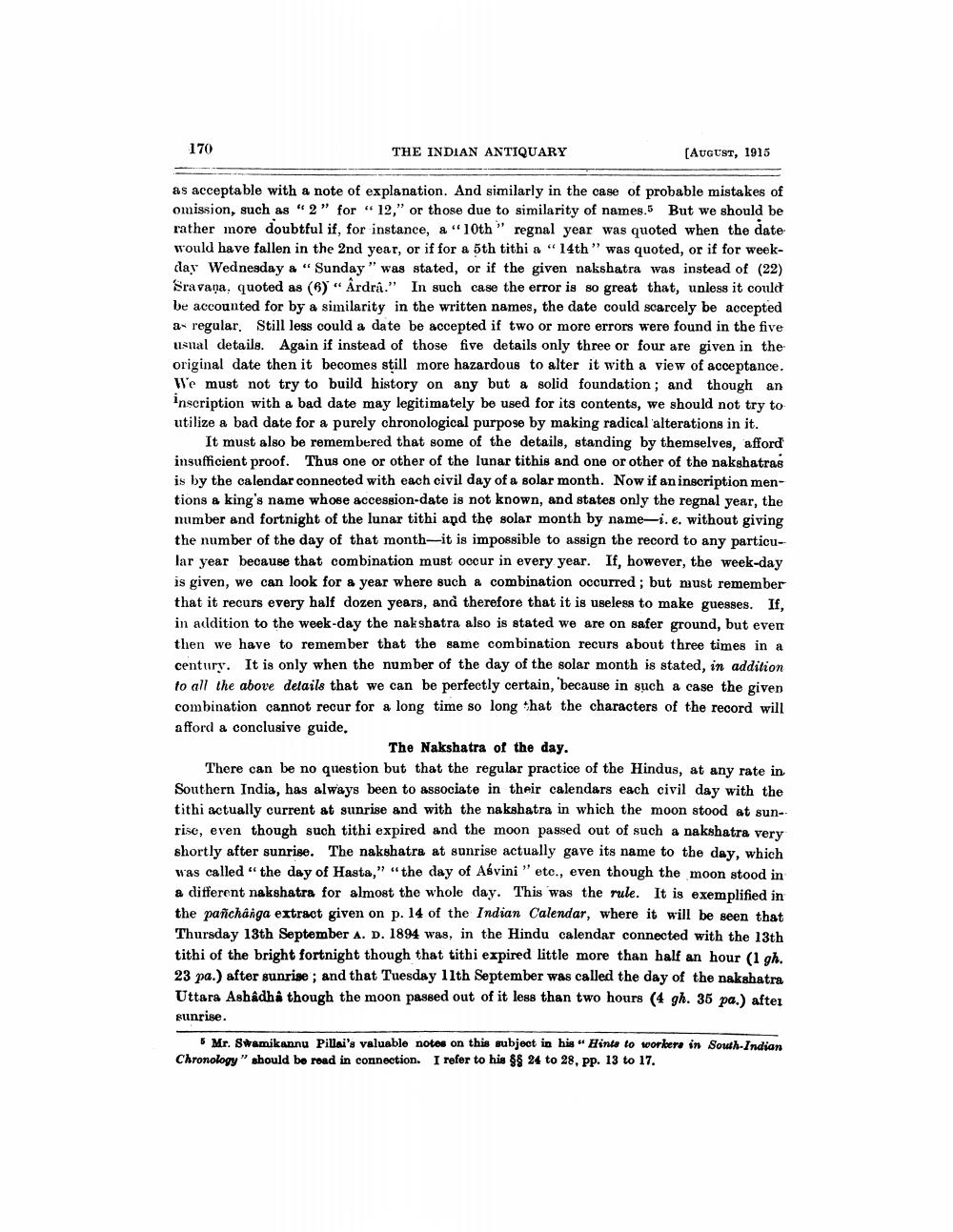________________
170
THE INDIAN ANTIQUARY
(AUGUST, 1915
as acceptable with a note of explanation. And similarly in the case of probable mistakes of omission, such as "2" for "12," or those due to similarity of names. But we should be rather more doubtful if, for instance, a "10th " regnal year was quoted when the date would have fallen in the 2nd year, or if for a 5th tithi a "14th" was quoted, or if for weekday Wednesday a "Sunday" was stated, or if the given nakshatra was instead of (22) Sravana, quoted as (6) "Ārdra.” In such case the error is so great that, unless it could be accounted for by a similarity in the written names, the date could scarcely be accepted a regular. Still less could a date be accepted if two or more errors were found in the five usnal details. Again if instead of those five details only three or four are given in the original date then it becomes still more hazardous to alter it with a view of acceptance. We must not try to build history on any but a solid foundation, and though an Inscription with a bad date may legitimately be used for its contents, we should not try to utilize a bad date for a purely chronological purpose by making radical alterations in it.
It must also be remembered that some of the details, standing by themselves, afford insufficient proof. Thus one or other of the lunar tithis and one or other of the nakshatras is by the calendar connected with each civil day of a solar month. Now if an inscription mentions a king's name whose accession-date is not known, and states only the regnal year, the number and fortnight of the lunar tithi and the solar month by name-i.e. without giving the number of the day of that month-it is impossible to assign the record to any particu-- lar year because that combination must occur in every year. If, however, the week-day is given, we can look for a year where such a combination occurred; but must remember that it recurs every half dozen years, and therefore that it is useless to make guesses. If, in addition to the week-day the nakshatra also is stated we are on safer ground, but even then we have to remember that the same combination recurs about three times in a century. It is only when the number of the day of the solar month is stated, in addition to all the above details that we can be perfectly certain, because in such a case the given combination cannot recur for a long time so long that the characters of the record will afford a conclusive guide.
The Nakshatra of the day. There can be no question but that the regular practice of the Hindus, at any rate in Southern India, has always been to associate in their calendars each civil day with the tithi actually current at sunrise and with the nakshatra in which the moon stood at sunrise, even though such tithi expired and the moon passed out of such a nakshatra very shortly after sunrise. The nakshatra at sunrise actually gave its name to the day, which was called "the day of Hasta," "the day of Aøvini" etc., even though the moon stood in a different nakshatra for almost the whole day. This was the rule. It is exemplified in the panchånga extract given on p. 14 of the Indian Calendar, where it will be seen that Thursday 13th September A. D. 1894 was, in the Hindu calendar connected with the 13th tithi of the bright fortnight though that tithi expired little more than half an hour (1 gh. 23 pa.) after sunrise ; and that Tuesday 11th September was called the day of the nakshatra Uttara Ashadhá though the moon passed out of it less than two hours (4 gh. 35 pa.) after sunrise.
5 Mr. Swamikannu Pillai's valuable notes on this subject in his " Hints to workers in South Indian Chronology" should be road in connection. I refer to his $8 24 to 28, pp. 13 to 17.




